

Write - Writing a literature review. What is a literature review?

A literature review is a critical analysis of published sources, or literature, on a particular topic. It is an assessment of the literature and provides a summary, classification, comparison and evaluation. At postgraduate level literature reviews can be incorporated into an article, a research report or thesis. At undergraduate level literature reviews can be a separate stand alone assessment.
CAS Authentication wanted! Know Your Child Better By Learning The Ages & Stages Of Child Development. Children go through distinct periods of development as they move from infants to young adults.

During each of these stages multiple changes in the development of the brain are taking place. What occurs and approximately when these developments take place are genetically determined. However, environmental circumstances and exchanges with key individuals within that environment have significant influence on how each child benefits from each developmental event. Ages and Stages is a term used to broadly outline key periods in the human development timeline. During each stage growth and development occur in the primary developmental domains including physical, intellectual, language and social – emotional. Infants/Babies (0 – 2 years) Raising a baby, especially for the first time, is both exciting and challenging. Toddlers/Preschoolers (2 – 5 years) When a child takes the first step on his or her own, a new phase in development begins. Child Development. American Psychological Association (APA)
Children’s services- Child development theorists. Skip to Navigation <p class="noscript">This page is better viewed with JavaScript enabled</p> Back to top Mary Ainsworth (1913-1999) Ainsworth supported Bowlby’s concept of a mother-baby attachment process and conducted further research in this area.
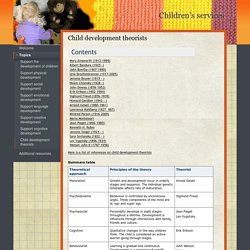
Ainsworth, through her research looking at the attachment process in both African and American cultures, identified the characteristics of a secure and insecure attachment between mother and baby. Erikson's Psychosocial Stages Summary Chart. Erik Erikson described development that occurs throughout the lifespan.
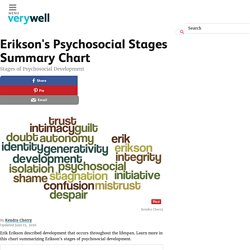
Learn more in this chart summarizing Erikson's stages of psychosocial development. More Resources: Learn more about psychosocial theories and Erik Erikson in the following articles: Biography of Erik EriksonErik Erikson's stage theory of psychosocial development contributed to our understanding of personality development throughout the lifespan.
Learn more about his life, career, and how early experiences led to his interest in identity. 1998. Family Formation: Adoptions The number of adoptions in Australia has dropped sharply from 9,798 in 1971-72 to 668 in 1995-96.
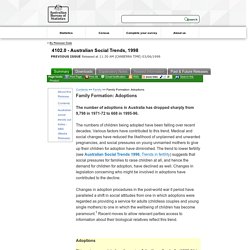
The numbers of children being adopted have been falling over recent decades. Various factors have contributed to this trend. Medical and social changes have reduced the likelihood of unplanned and unwanted pregnancies, and social pressures on young unmarried mothers to give up their children for adoption have diminished. The trend to lower fertility (see Australian Social Trends 1996, Trends in fertility) suggests that social pressures for families to raise children at all, and hence the demand for children for adoption, have declined as well. Trends in adoptionAustralia-wide statistics on the number of adoptions have been available since the year ended 30 June 1969. The major turnaround in the number of adoptions after 1972 occurred at a time of rapidly changing social attitudes surrounding the plight of young unmarried mothers.
Year ending 30 June. Adoption - Child Safety Services, Department of Communities, Child Safety and Disability Services (Queensland Government) Community Services - Adoption. What is adoption?
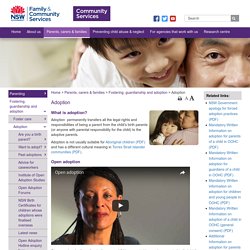
Adoption permanently transfers all the legal rights and responsibilities of being a parent from the child's birth parents (or anyone with parental responsibility for the child) to the adoptive parents. Adoption is not usually suitable for Aboriginal children and has a different cultural meaning in Torres Strait Islander communities. Open adoption Openness in adoption refers to the way a child is supported to remain connected to their birth family and cultural heritage. Open adoption recognises that children often benefit when both their families (birth and adoptive) remain in contact with each other after an adoption order has been made.
Want to adopt? Parenting Ideas: Child Development & Parenting advice. Parenting expert. Child care. Fact file: 11 facts about child care in Australia - Fact Check. Updated Following the scrapping of Prime Minister Tony Abbott's signature paid parental leave scheme, the Federal Government is now expected to turn its attention to child care.

A Productivity Commission report released in February identified both access and affordability as major issues. "The Australian Government currently spends almost $7 billion a year to support families to access quality and affordable child care. "It is important that these taxpayer resources are spent in the best way to enable families to stay in work, get back to work and give their children the best possible start in life," Social Services Minister Scott Morrison said when releasing the report.
Family structure, child outcomes and environmental mediators - Changing patterns of family structure and formation. There is abundant evidence that Australian families are undergoing rapid change.
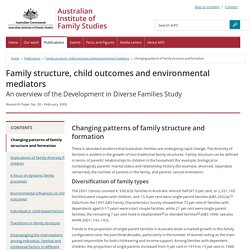
The diversity of families is evident in the growth of non-traditional family structures. Family structure can be defined in terms of parents' relationships to children in the household (for example, biological or nonbiological), parents' marital status and relationship history (for example, divorced, separated, remarried), the number of parents in the family, and parents' sexual orientation. AW15 2 Australias changing family structure.